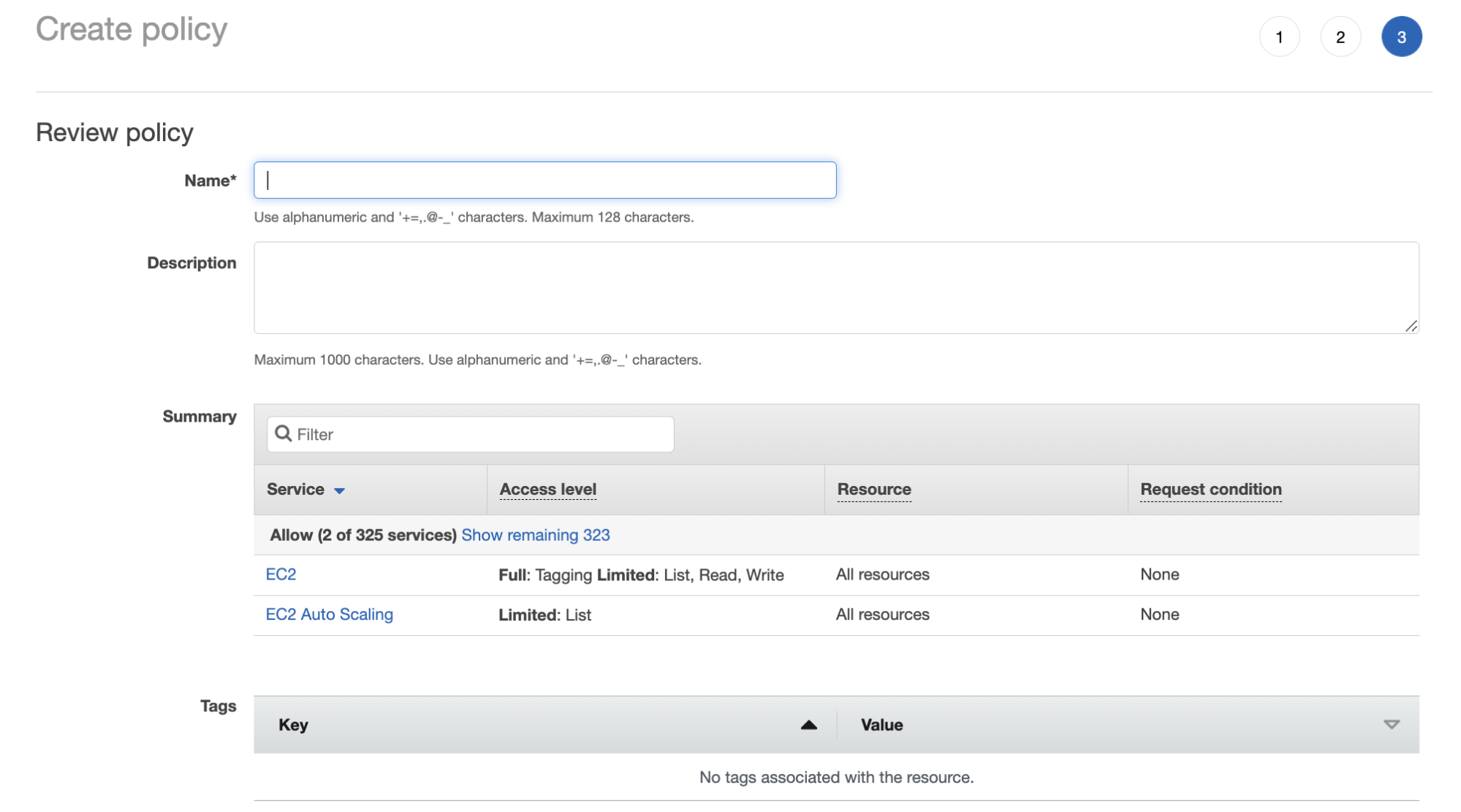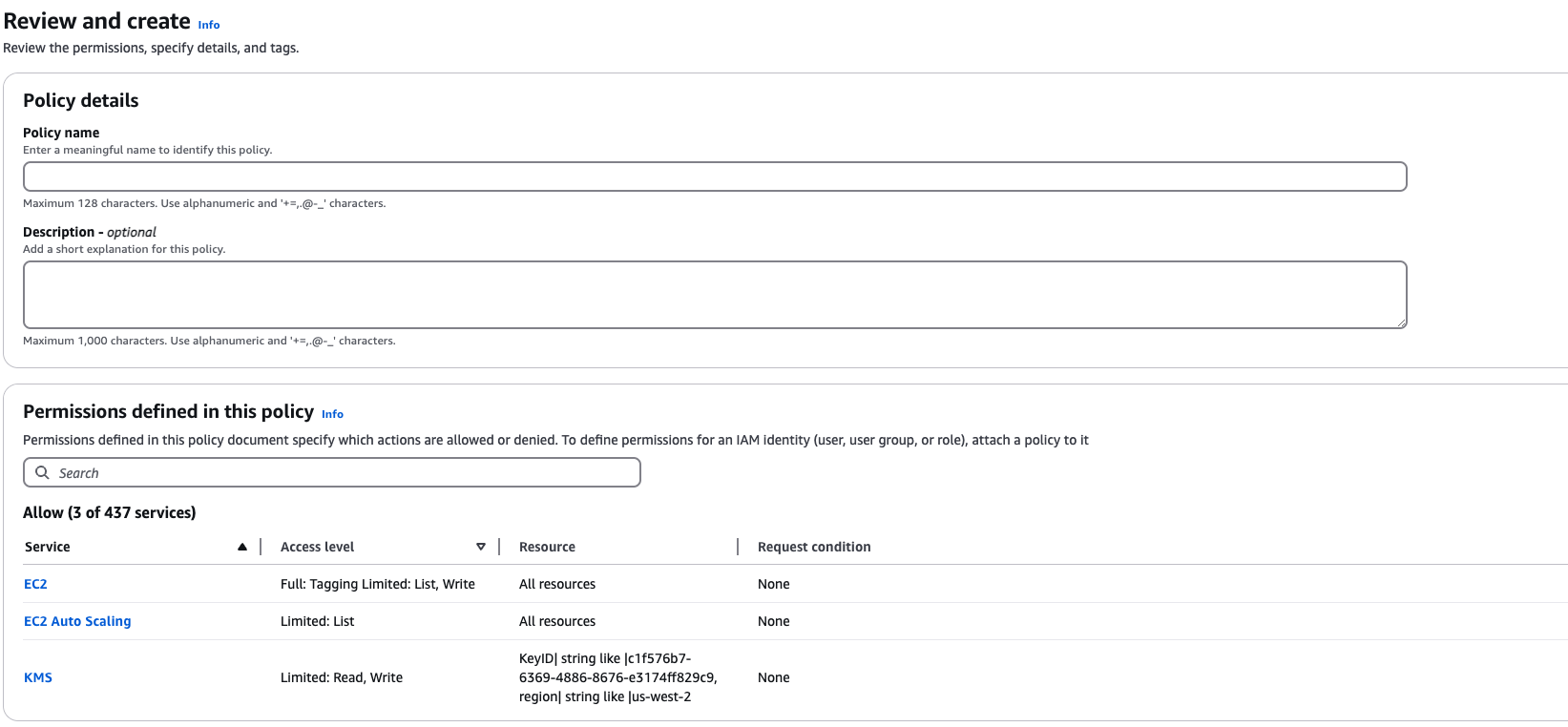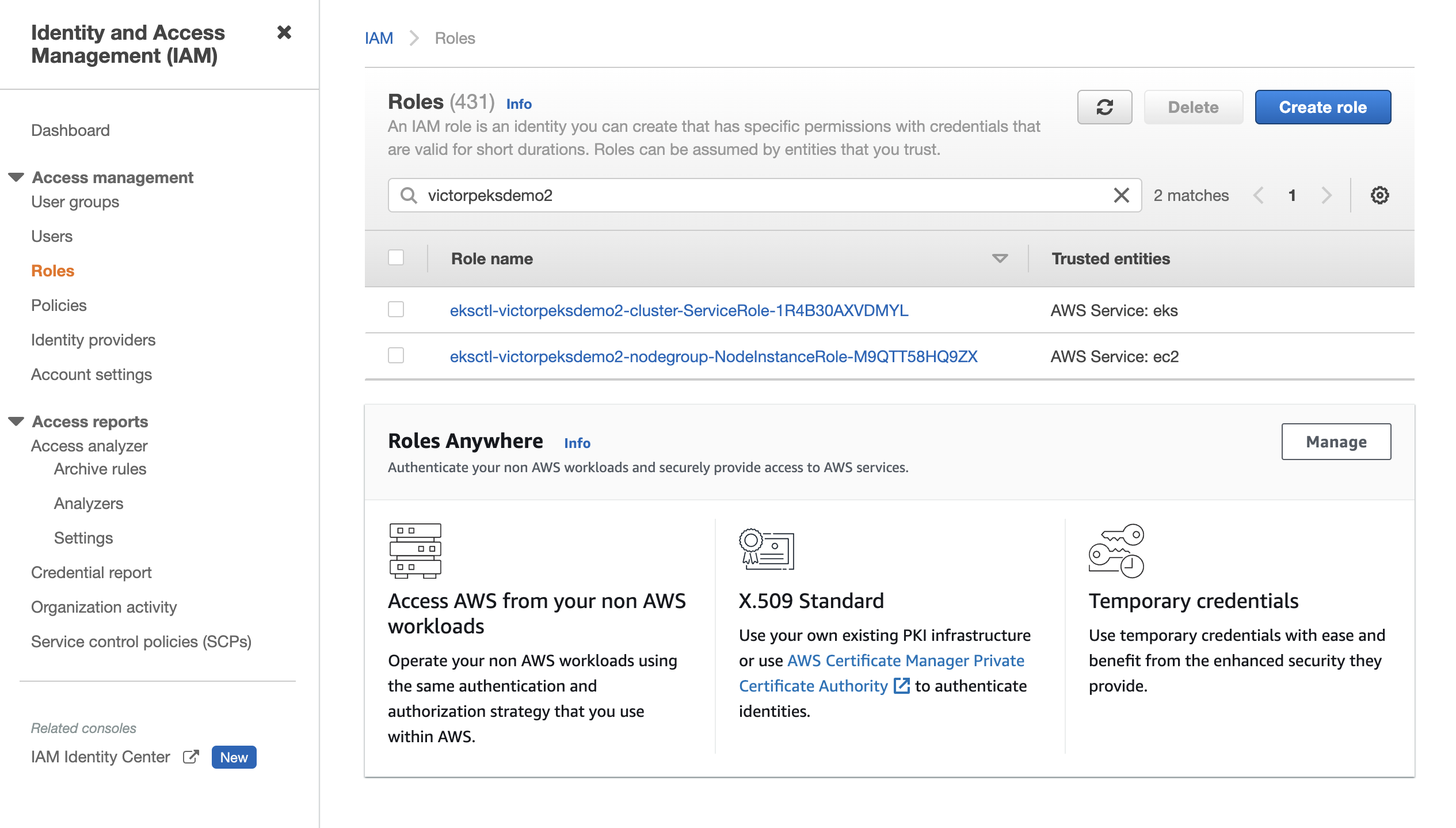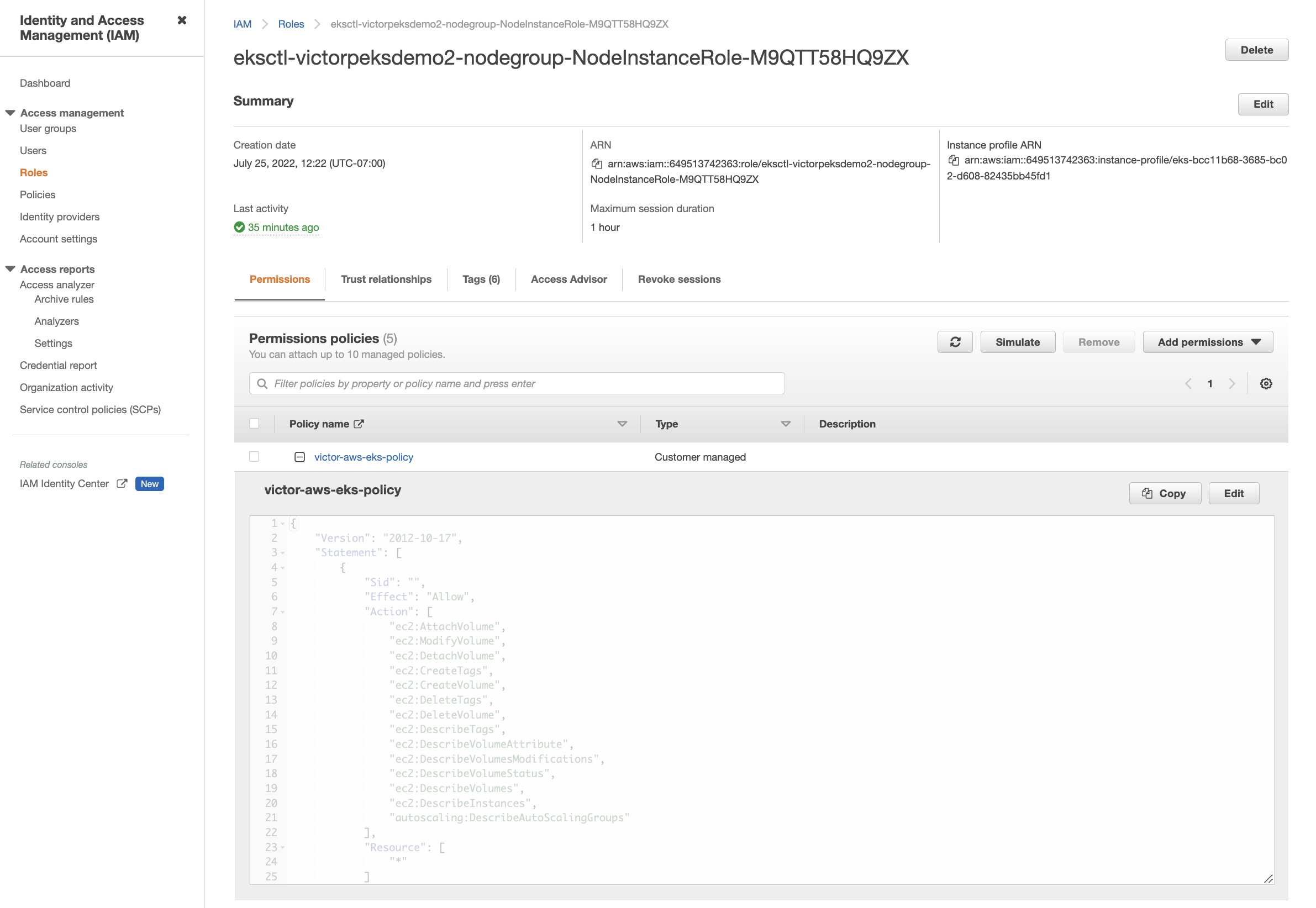Install Portworx on Elastic Kubernetes Service and EKS-D
This topic explains how to install Portworx on Amazon Web Services (AWS) Elastic Kubernetes Service (EKS) and EKS-D with PX-StoreV1 or PX-StoreV2 backend.
PX-StoreV1 is the traditional storage backend for Portworx Enterprise, and PX-StoreV2, focuses purely on volume management with optimized metadata handling and performance metrics, making it more suitable for high-performance environments. To know more about these backends, refer to the PX-StoreV2 concept topic.
Prerequisites
- PX-StoreV1
- PX-StoreV2
-
An AWS EKS cluster that meets the Portworx prerequisites
-
You must have the supported disk types
-
Recommended disk sizes:
- GP2: 150 (GB) size disk is needed as the minimum IOP require.
- GP3 specify IOPS required from EBS volume and specify throughput for EBS volume
- IO1 specify IOPS required from EBS volume
-
For production environments Portworx by Pure Storage recommends 3 Availability Zones (AZs)
-
For installation on EKS version 1.30 or later, ensure to increase the
HttpPutResponseHopLimitto 3 for all nodes on which Portworx will be installed by running the following command:aws ec2 modify-instance-metadata-options --instance-id <instanceID> --http-put-response-hop-limit 3 --http-endpoint enabled -
Portworx by Pure Storage recommends you set Max storage nodes per availability zone, Portworx will ensure that many storage nodes exist in the zone
You must have a Kubernetes cluster deployed on infrastructure that meets the following minimum requirements for Portworx with PX-StoreV2:
-
Linux kernel version: 4.20 or newer (minimum), 5.0 or newer (recommended), with the following packages:
- Rhel: device-mapper mdadm lvm2 device-mapper-persistent-data augeas
- Debian: dmsetup mdadm lvm2 thin-provisioning-tools augeas-tools
- Suse: dmsetup mdadm lvm2 device-mapper-persistent-data augeas
- Ubuntu: dmsetup mdadm lvm2 thin-provisioning-tools augeas-tools
noteDuring installation, Portworx will automatically try to pull the required packages from distribution specific repositories. This is a mandatory requirement and installation will fail if this prerequisite is not met.
-
For installation on EKS version 1.30 or later, ensure to increase the
HttpPutResponseHopLimitto 3 for all nodes on which Portworx will be installed by running the following command:aws ec2 modify-instance-metadata-options --instance-id <instanceID> --http-put-response-hop-limit 3 --http-endpoint enabled -
A minimum of 64 GB system metadata device on each node where you want to deploy Portworx. If you do not provide a metadata device, one will be automatically added to the spec.
-
An SSD/NVME or GP3/IO1 drive type with a memory of more than 8 GB per node.
-
A minimum of 8 cores CPU per node.
- You can follow the same procedures explained in this topic to deploy Portworx on AWS Outposts.
- You can also follow the steps in this topic to install Portworx on EKS-D.
- For details on GP2, GP3, and IO1 performance characteristics, refer to the AWS documentation.
Create an IAM policy
Provide the permissions for all the instances in the autoscaling cluster by creating an IAM role.
Perform the following steps on your AWS Console:
- For non-encrypted volumes
- For encrypted volumes
-
Navigate to the IAM page on your AWS console, then select Policies under the Identity and Access Management (IAM) sidebar section, then select the Create Policy button in the upper right corner:

-
Choose the JSON tab, then paste the following permissions into the editor, providing your own value for
Sidif applicable. You can either use the minimum permissions required or use the permissions required for disk encryption:noteThese are the minimum permissions needed for storage operations for a Portworx cluster. For complete permissions required for all of Portworx storage operations, see the credentials reference.
{
"Version": "2012-10-17",
"Statement": [
{
"Sid": "ec2",
"Effect": "Allow",
"Action": [
"ec2:AttachVolume",
"ec2:ModifyVolume",
"ec2:DetachVolume",
"ec2:CreateTags",
"ec2:CreateVolume",
"ec2:DeleteTags",
"ec2:DeleteVolume",
"ec2:DescribeTags",
"ec2:DescribeVolumeAttribute",
"ec2:DescribeVolumesModifications",
"ec2:DescribeVolumeStatus",
"ec2:DescribeVolumes",
"ec2:DescribeInstances",
"autoscaling:DescribeAutoScalingGroups"
],
"Resource": [
"*"
]
},
{
"Sid": "VisualEditor0",
"Effect": "Allow",
"Action": "ec2:DeleteInternetGateway",
"Resource": [
"arn:aws:iam::*:role/eksctl-*",
"arn:aws:ec2:*:*:internet-gateway/*"
]
},
{
"Sid": "VisualEditor1",
"Effect": "Allow",
"Action": "ec2:DeleteInternetGateway",
"Resource": "arn:aws:iam::*:instance-profile/eksctl-*"
},
{
"Sid": "VisualEditor2",
"Effect": "Allow",
"Action": [
"iam:CreateInstanceProfile",
"iam:DeleteInstanceProfile",
"iam:GetRole",
"iam:GetInstanceProfile",
"iam:RemoveRoleFromInstanceProfile",
"iam:CreateRole",
"iam:DeleteRole",
"iam:AttachRolePolicy",
"iam:PutRolePolicy",
"iam:AddRoleToInstanceProfile",
"iam:ListInstanceProfilesForRole",
"iam:PassRole",
"iam:CreateServiceLinkedRole",
"iam:DetachRolePolicy",
"iam:DeleteRolePolicy",
"iam:DeleteServiceLinkedRole",
"iam:GetRolePolicy"
],
"Resource": [
"arn:aws:iam::*:instance-profile/eksctl-*",
"arn:aws:iam::*:role/eksctl-*"
]
},
{
"Sid": "VisualEditor3",
"Effect": "Allow",
"Action": [
"ec2:AuthorizeSecurityGroupIngress",
"ec2:DeleteSubnet",
"ec2:AttachInternetGateway",
"ec2:DescribeSnapshots",
"ec2:DeleteSnapshot",
"ec2:DeleteRouteTable",
"ec2:AssociateRouteTable",
"ec2:DescribeInternetGateways",
"ec2:CreateRoute",
"ec2:CreateInternetGateway",
"ec2:RevokeSecurityGroupEgress",
"autoscaling:DescribeAutoScalingGroups",
"autoscaling:UpdateAutoScalingGroup",
"ec2:DeleteInternetGateway",
"ec2:DescribeKeyPairs",
"ec2:DescribeRouteTables",
"ecr:BatchCheckLayerAvailability",
"ecr:GetLifecyclePolicy",
"ecr:DescribeImageScanFindings",
"ec2:ImportKeyPair",
"ec2:DescribeLaunchTemplates",
"ec2:CreateTags",
"ecr:GetDownloadUrlForLayer",
"ec2:CreateRouteTable",
"cloudformation:*",
"ec2:RunInstances",
"ecr:GetAuthorizationToken",
"ec2:DetachInternetGateway",
"ec2:DisassociateRouteTable",
"ec2:RevokeSecurityGroupIngress",
"ec2:DescribeImageAttribute",
"ecr:BatchGetImage",
"ecr:DescribeImages",
"ec2:DeleteNatGateway",
"ec2:DeleteVpc",
"autoscaling:DeleteAutoScalingGroup",
"eks:*",
"ec2:CreateSubnet",
"ec2:DescribeSubnets",
"autoscaling:CreateAutoScalingGroup",
"ec2:DescribeAddresses",
"ec2:DeleteTags",
"elasticfilesystem:*",
"ec2:CreateNatGateway",
"autoscaling:DescribeLaunchConfigurations",
"ec2:CreateVpc",
"ecr:ListTagsForResource",
"ecr:ListImages",
"ec2:DescribeVpcAttribute",
"ec2:DescribeAvailabilityZones",
"autoscaling:DescribeScalingActivities",
"ec2:CreateSecurityGroup",
"sts:DecodeAuthorizationMessage",
"ec2:CreateSnapshot",
"ec2:ModifyVpcAttribute",
"ecr:DescribeRepositories",
"ec2:ReleaseAddress",
"ec2:AuthorizeSecurityGroupEgress",
"ec2:DeleteLaunchTemplate",
"ec2:DescribeTags",
"ecr:GetLifecyclePolicyPreview",
"ec2:DeleteRoute",
"ec2:DescribeLaunchTemplateVersions",
"ec2:DescribeNatGateways",
"ec2:AllocateAddress",
"ec2:DescribeSecurityGroups",
"ec2:DescribeImages",
"autoscaling:CreateLaunchConfiguration",
"ec2:CreateLaunchTemplate",
"autoscaling:DeleteLaunchConfiguration",
"sts:Get*",
"ec2:DescribeVpcs",
"ec2:DeleteSecurityGroup",
"ecr:GetRepositoryPolicy"
],
"Resource": "*"
},
{
"Sid": "VisualEditor4",
"Effect": "Allow",
"Action": "iam:ListInstanceProfiles",
"Resource": [
"arn:aws:iam::*:instance-profile/eksctl-*",
"arn:aws:iam::*:role/eksctl-*"
]
}
]
} -
Name and create the policy.

-
Navigate to the IAM page on your AWS console, then select Policies under the Identity and Access Management (IAM) sidebar section, then select the Create Policy button in the upper right corner:

-
Choose the JSON tab, then paste the following permissions into the editor, providing your own value for
Sidif applicable. You can either use the minimum permissions required or use the permissions required for disk encryption:noteThese are the minimum permissions needed for storage operations for a Portworx cluster. For complete permissions required for all of Portworx storage operations, see the credentials reference.
{
"Version": "2012-10-17",
"Statement": [
{
"Sid": "kms",
"Effect": "Allow",
"Action": [
"kms:Encrypt",
"kms:Decrypt",
"kms:ReEncrypt*",
"kms:GenerateDataKey*",
"kms:DescribeKey"
],
"Resource": [
"arn:aws:kms:us-west-2:383347425723:key/c1f576b7-6369-xxxx-xxxx-xxxxxxxxxxxxxx"
]
},
{
"Sid": "ec2",
"Effect": "Allow",
"Action": [
"ec2:AttachVolume",
"ec2:ModifyVolume",
"ec2:DetachVolume",
"ec2:CreateTags",
"ec2:CreateVolume",
"ec2:DeleteTags",
"ec2:DeleteVolume",
"ec2:DescribeTags",
"ec2:DescribeVolumeAttribute",
"ec2:DescribeVolumesModifications",
"ec2:DescribeVolumeStatus",
"ec2:DescribeVolumes",
"ec2:DescribeInstances",
"autoscaling:DescribeAutoScalingGroups"
],
"Resource": [
"*"
]
},
{
"Sid": "VisualEditor0",
"Effect": "Allow",
"Action": "ec2:DeleteInternetGateway",
"Resource": [
"arn:aws:iam::*:role/eksctl-*",
"arn:aws:ec2:*:*:internet-gateway/*"
]
},
{
"Sid": "VisualEditor1",
"Effect": "Allow",
"Action": "ec2:DeleteInternetGateway",
"Resource": "arn:aws:iam::*:instance-profile/eksctl-*"
},
{
"Sid": "VisualEditor2",
"Effect": "Allow",
"Action": [
"iam:CreateInstanceProfile",
"iam:DeleteInstanceProfile",
"iam:GetRole",
"iam:GetInstanceProfile",
"iam:RemoveRoleFromInstanceProfile",
"iam:CreateRole",
"iam:DeleteRole",
"iam:AttachRolePolicy",
"iam:PutRolePolicy",
"iam:AddRoleToInstanceProfile",
"iam:ListInstanceProfilesForRole",
"iam:PassRole",
"iam:CreateServiceLinkedRole",
"iam:DetachRolePolicy",
"iam:DeleteRolePolicy",
"iam:DeleteServiceLinkedRole",
"iam:GetRolePolicy"
],
"Resource": [
"arn:aws:iam::*:instance-profile/eksctl-*",
"arn:aws:iam::*:role/eksctl-*"
]
},
{
"Sid": "VisualEditor3",
"Effect": "Allow",
"Action": [
"ec2:AuthorizeSecurityGroupIngress",
"ec2:DeleteSubnet",
"ec2:AttachInternetGateway",
"ec2:DescribeSnapshots",
"ec2:DeleteSnapshot",
"ec2:DeleteRouteTable",
"ec2:AssociateRouteTable",
"ec2:DescribeInternetGateways",
"ec2:CreateRoute",
"ec2:CreateInternetGateway",
"ec2:RevokeSecurityGroupEgress",
"autoscaling:DescribeAutoScalingGroups",
"autoscaling:UpdateAutoScalingGroup",
"ec2:DeleteInternetGateway",
"ec2:DescribeKeyPairs",
"ec2:DescribeRouteTables",
"ecr:BatchCheckLayerAvailability",
"ecr:GetLifecyclePolicy",
"ecr:DescribeImageScanFindings",
"ec2:ImportKeyPair",
"ec2:DescribeLaunchTemplates",
"ec2:CreateTags",
"ecr:GetDownloadUrlForLayer",
"ec2:CreateRouteTable",
"cloudformation:*",
"ec2:RunInstances",
"ecr:GetAuthorizationToken",
"ec2:DetachInternetGateway",
"ec2:DisassociateRouteTable",
"ec2:RevokeSecurityGroupIngress",
"ec2:DescribeImageAttribute",
"ecr:BatchGetImage",
"ecr:DescribeImages",
"ec2:DeleteNatGateway",
"ec2:DeleteVpc",
"autoscaling:DeleteAutoScalingGroup",
"eks:*",
"ec2:CreateSubnet",
"ec2:DescribeSubnets",
"autoscaling:CreateAutoScalingGroup",
"ec2:DescribeAddresses",
"ec2:DeleteTags",
"elasticfilesystem:*",
"ec2:CreateNatGateway",
"autoscaling:DescribeLaunchConfigurations",
"ec2:CreateVpc",
"ecr:ListTagsForResource",
"ecr:ListImages",
"ec2:DescribeVpcAttribute",
"ec2:DescribeAvailabilityZones",
"autoscaling:DescribeScalingActivities",
"ec2:CreateSecurityGroup",
"sts:DecodeAuthorizationMessage",
"ec2:CreateSnapshot",
"ec2:ModifyVpcAttribute",
"ecr:DescribeRepositories",
"ec2:ReleaseAddress",
"ec2:AuthorizeSecurityGroupEgress",
"ec2:DeleteLaunchTemplate",
"ec2:DescribeTags",
"ecr:GetLifecyclePolicyPreview",
"ec2:DeleteRoute",
"ec2:DescribeLaunchTemplateVersions",
"ec2:DescribeNatGateways",
"ec2:AllocateAddress",
"ec2:DescribeSecurityGroups",
"ec2:DescribeImages",
"autoscaling:CreateLaunchConfiguration",
"ec2:CreateLaunchTemplate",
"autoscaling:DeleteLaunchConfiguration",
"sts:Get*",
"ec2:DescribeVpcs",
"ec2:DeleteSecurityGroup",
"ecr:GetRepositoryPolicy"
],
"Resource": "*"
},
{
"Sid": "VisualEditor4",
"Effect": "Allow",
"Action": "iam:ListInstanceProfiles",
"Resource": [
"arn:aws:iam::*:instance-profile/eksctl-*",
"arn:aws:iam::*:role/eksctl-*"
]
}
]
} -
Name and create the policy.

Attach IAM policy
Attach the above created policy to your Node instance role or user account.
- Attach policy to a Node Instanace Role
- Attach policy to your AWS user account
Follow the instructions below for attaching the policy with your NodeInstanceRole:
-
From the IAM page, click Roles in the left pane.
-
On the Roles page, search for and select your nodegroup
NodeInstanceRoleusing your cluster name. The following example showseksctl-victorpeksdemo2-nodegroup-NodeInstanceRole-M9QTT58HQ9ZXas the nodegroup Instance Role: note
noteIf there are more than one nodegroup
NodeInstanceRolefor your cluster, attach the policy to thoseNodeInstanceRoles as well. -
Attach the previously created policy by selecting Attach policies from the Add permissions dropdown on the right side of the screen:

-
Under Other permissions policies, search for your policy name. Select your policy name and select the Attach policies button to attach it.
The policy you attached will appear under Permissions policies if successful:

-
From the IAM page, click Users in the left pane.
-
On the Users page, search for and select your AWS user account.
-
On your user account detail page, click Add permissions in the upper right corner of the Permissions policies section.
-
Select Attach policies directly in the Permissions options section.
-
Use the search bar in the Permissions policies section to search and select your previously created policy, and click Next.
-
Click Add permissions to attach the policy to your AWS user account.
Once the policy is successfully attached to your user account, you will be navigated back to your user account detail page and the policy will be listed in the Permissions policies section.
Deploy Portworx
Follow this section to deploy Portworx.
Generate specs
To install Portworx with Kubernetes, you must generate Kubernetes manifests that you will deploy in your cluster.
-
Navigate to Portworx Central and log in, or create an account, then follow the process to generate a spec.
-
Select Portworx Enterprise from the product catalog and click Continue.
-
On the Product Line page, choose any option depending on which license you intend to use, then select Continue to start the spec generator.
-
For Platform, select your K8s AWS as your cloud environment.
-
For Distribution Name, select Elastic Kubernetes Service (EKS).
-
Click Save Spec to generate the specs. You may customize the storage and network for your Portworx cluster if needed, by clicking on Customize.
As the PX-StoreV2 option is set to Auto, the Operator performs a pre-flight check across the cluster to determine if your cluster is capable of deploying Portworx with the PX-StoreV2 datastore. If the pre-flight check passes for each node, then PX-StoreV2 will be automatically selected as your default datastore during Portworx installation.
Apply specs
Apply the Operator and StorageCluster specs you generated in the section above using the kubectl apply command:
-
Deploy the Operator:
kubectl apply -f 'https://install.portworx.com/<version-number>?comp=pxoperator'serviceaccount/portworx-operator created
podsecuritypolicy.policy/px-operator created
clusterrole.rbac.authorization.k8s.io/portworx-operator created
clusterrolebinding.rbac.authorization.k8s.io/portworx-operator created
deployment.apps/portworx-operator created -
Deploy the StorageCluster:
kubectl apply -f 'https://install.portworx.com/<version-number>?operator=true&mc=false&kbver=&b=true&kd=type%3Dgp2%2Csize%3D150&s=%22type%3Dgp2%2Csize%3D150%22&c=px-cluster-XXXX-XXXX&eks=true&stork=true&csi=true&mon=true&tel=false&st=k8s&e==AWS_ACCESS_KEY_ID%3XXXX%2CAWS_SECRET_ACCESS_KEY%3XXXX&promop=true'storagecluster.core.libopenstorage.org/px-cluster-xxxxxxxx-xxxx-xxxx-xxxx-8dfd338e915b created
Monitor Portworx nodes
-
Enter the following
kubectl getcommand and wait until all Portworx nodes show asOnlinein the output:kubectl -n <px-namespace> get storagenodes -l name=portworxNAME ID STATUS VERSION AGE
username-k8s1-node0 xxxxxxxx-xxxx-xxxx-xxxx-43cf085e764e Online 2.11.1-3a5f406 4m52s
username-k8s1-node1 xxxxxxxx-xxxx-xxxx-xxxx-4597de6fdd32 Online 2.11.1-3a5f406 4m52s
username-k8s1-node2 xxxxxxxx-xxxx-xxxx-xxxx-e2169ffa111c Online 2.11.1-3a5f406 4m52s -
Enter the following
kubectl describecommand with theNAMEof one of the Portworx nodes you retrieved above to show the current installation status for individual nodes:kubectl -n <px-namespace> describe storagenode <portworx-node-name>...
Events:
Type Reason Age From Message
---- ------ ---- ---- -------
Normal PortworxMonitorImagePullInPrgress 7m48s portworx, k8s-node-2 Portworx image portworx/px-enterprise:2.10.1.1 pull and extraction in progress
Warning NodeStateChange 5m26s portworx, k8s-node-2 Node is not in quorum. Waiting to connect to peer nodes on port 9002.
Normal NodeStartSuccess 5m7s portworx, k8s-node-2 PX is ready on this nodenote- In your output, the image pulled will differ based on your chosen Portworx license type and version.
- For Portworx Enterprise, the default license activated on the cluster is a 30 day trial that you can convert to a SaaS-based model or a generic fixed license.
Verify your Portworx installation Once you've installed Portworx, you can perform the following tasks to verify that Portworx has installed correctly.
Verify if all pods are running
Enter the following kubectl get pods command to list and filter the results for Portworx pods:
kubectl get pods -n <px-namespace> -o wide | grep -e portworx -e px
portworx-api-774c2 1/1 Running 0 2m55s 192.168.121.196 username-k8s1-node0 <none> <none>
portworx-api-t4lf9 1/1 Running 0 2m55s 192.168.121.99 username-k8s1-node1 <none> <none>
portworx-api-dvw64 1/1 Running 0 2m55s 192.168.121.99 username-k8s1-node2 <none> <none>
portworx-kvdb-94bpk 1/1 Running 0 4s 192.168.121.196 username-k8s1-node0 <none> <none>
portworx-kvdb-8b67l 1/1 Running 0 10s 192.168.121.196 username-k8s1-node1 <none> <none>
portworx-kvdb-fj72p 1/1 Running 0 30s 192.168.121.196 username-k8s1-node2 <none> <none>
portworx-operator-58967ddd6d-kmz6c 1/1 Running 0 4m1s 10.244.1.99 username-k8s1-node0 <none> <none>
prometheus-px-prometheus-0 2/2 Running 0 2m41s 10.244.1.105 username-k8s1-node0 <none> <none>
px-cluster-xxxxxxxx-xxxx-xxxx-xxxx-3e9bf3cd834d-9gs79 2/2 Running 0 2m55s 192.168.121.196 username-k8s1-node0 <none> <none>
px-cluster-xxxxxxxx-xxxx-xxxx-xxxx-3e9bf3cd834d-vpptx 2/2 Running 0 2m55s 192.168.121.99 username-k8s1-node1 <none> <none>
px-cluster-xxxxxxxx-xxxx-xxxx-xxxx-3e9bf3cd834d-bxmpn 2/2 Running 0 2m55s 192.168.121.191 username-k8s1-node2 <none> <none>
px-csi-ext-868fcb9fc6-54bmc 4/4 Running 0 3m5s 10.244.1.103 username-k8s1-node0 <none> <none>
px-csi-ext-868fcb9fc6-8tk79 4/4 Running 0 3m5s 10.244.1.102 username-k8s1-node2 <none> <none>
px-csi-ext-868fcb9fc6-vbqzk 4/4 Running 0 3m5s 10.244.3.107 username-k8s1-node1 <none> <none>
px-prometheus-operator-59b98b5897-9nwfv 1/1 Running 0 3m3s 10.244.1.104 username-k8s1-node0 <none> <none>
Note the name of one of your px-cluster pods. You'll run pxctl commands from these pods in following steps.
Verify Portworx cluster status
You can find the status of the Portworx cluster by running pxctl status commands from a pod. Enter the following kubectl exec command, specifying the pod name you retrieved in the previous section:
kubectl exec <pod-name> -n <px-namespace> -- /opt/pwx/bin/pxctl status
Defaulted container "portworx" out of: portworx, csi-node-driver-registrar
Status: PX is operational
Telemetry: Disabled or Unhealthy
Metering: Disabled or Unhealthy
License: Trial (expires in 31 days)
Node ID: xxxxxxxx-xxxx-xxxx-xxxx-70c31d0f478e
IP: 192.168.121.99
Local Storage Pool: 1 pool
POOL IO_PRIORITY RAID_LEVEL USABLE USED STATUS ZONE REGION
0 HIGH raid0 3.0 TiB 10 GiB Online default default
Local Storage Devices: 3 devices
Device Path Media Type Size Last-Scan
0:1 /dev/vdb STORAGE_MEDIUM_MAGNETIC 1.0 TiB 14 Jul 22 22:03 UTC
0:2 /dev/vdc STORAGE_MEDIUM_MAGNETIC 1.0 TiB 14 Jul 22 22:03 UTC
0:3 /dev/vdd STORAGE_MEDIUM_MAGNETIC 1.0 TiB 14 Jul 22 22:03 UTC
* Internal kvdb on this node is sharing this storage device /dev/vdc to store its data.
total - 3.0 TiB
Cache Devices:
* No cache devices
Cluster Summary
Cluster ID: px-cluster-xxxxxxxx-xxxx-xxxx-xxxx-3e9bf3cd834d
Cluster UUID: xxxxxxxx-xxxx-xxxx-xxxx-6f3fd5522eae
Scheduler: kubernetes
Nodes: 3 node(s) with storage (3 online)
IP ID SchedulerNodeName Auth StorageNode Used Capacity Status StorageStatus Version Kernel OS
192.168.121.196 xxxxxxxx-xxxx-xxxx-xxxx-fad8c65b8edc username-k8s1-node0 Disabled Yes 10 GiB 3.0 TiB Online Up 2.11.0-81faacc 3.10.0-1127.el7.x86_64 CentOS Linux 7 (Core)
192.168.121.99 xxxxxxxx-xxxx-xxxx-xxxx-70c31d0f478e username-k8s1-node1 Disabled Yes 10 GiB 3.0 TiB Online Up (This node) 2.11.0-81faacc 3.10.0-1127.el7.x86_64 CentOS Linux 7 (Core)
192.168.121.191 xxxxxxxx-xxxx-xxxx-xxxx-19d45b4c541a username-k8s1-node2 Disabled Yes 10 GiB 3.0 TiB Online Up 2.11.0-81faacc 3.10.0-1127.el7.x86_64 CentOS Linux 7 (Core)
Global Storage Pool
Total Used : 30 GiB
Total Capacity : 9.0 TiB
Create your first PVC
For your apps to use persistent volumes powered by Portworx, you must use a StorageClass that references Portworx as the provisioner. Portworx includes a number of default StorageClasses, which you can reference with PersistentVolumeClaims (PVCs) you create. For a more general overview of how storage works within Kubernetes, refer to the Persistent Volumes section of the Kubernetes documentation.
Perform the following steps to create a PVC:
- Create a PVC referencing the
px-csi-dbdefault StorageClass and save the file:
kind: PersistentVolumeClaim
apiVersion: v1
metadata:
name: px-check-pvc
spec:
storageClassName: px-csi-db
accessModes:
- ReadWriteOnce
resources:
requests:
storage: 2Gi
- Run the kubectl apply command to create a PVC:
kubectl apply -f <your-pvc-name>.yaml
persistentvolumeclaim/example-pvc created
Verify your StorageClass and PVC
- Enter the
kubectl get storageclasscommand:
kubectl get storageclass
NAME PROVISIONER RECLAIMPOLICY VOLUMEBINDINGMODE ALLOWVOLUMEEXPANSION AGE
px-csi-db pxd.portworx.com Delete Immediate true 43d
px-csi-db-cloud-snapshot pxd.portworx.com Delete Immediate true 43d
px-csi-db-cloud-snapshot-encrypted pxd.portworx.com Delete Immediate true 43d
px-csi-db-encrypted pxd.portworx.com Delete Immediate true 43d
px-csi-db-local-snapshot pxd.portworx.com Delete Immediate true 43d
px-csi-db-local-snapshot-encrypted pxd.portworx.com Delete Immediate true 43d
px-csi-replicated pxd.portworx.com Delete Immediate true 43d
px-csi-replicated-encrypted pxd.portworx.com Delete Immediate true 43d
px-db kubernetes.io/portworx-volume Delete Immediate true 43d
px-db-cloud-snapshot kubernetes.io/portworx-volume Delete Immediate true 43d
px-db-cloud-snapshot-encrypted kubernetes.io/portworx-volume Delete Immediate true 43d
px-db-encrypted kubernetes.io/portworx-volume Delete Immediate true 43d
px-db-local-snapshot kubernetes.io/portworx-volume Delete Immediate true 43d
px-db-local-snapshot-encrypted kubernetes.io/portworx-volume Delete Immediate true 43d
px-replicated kubernetes.io/portworx-volume Delete Immediate true 43d
px-replicated-encrypted kubernetes.io/portworx-volume Delete Immediate true 43d
stork-snapshot-sc stork-snapshot Delete Immediate true 43d
kubectl returns details about the StorageClasses available to you. Verify that px-csi-db appears in the list.
- Enter the
kubectl get pvccommand. If this is the only StorageClass and PVC that you've created, you should see only one entry in the output:
kubectl get pvc <your-pvc-name>
NAME STATUS VOLUME CAPACITY ACCESS MODES STORAGECLASS AGE
example-pvc Bound pvc-xxxxxxxx-xxxx-xxxx-xxxx-2377767c8ce0 2Gi RWO example-storageclass 3m7s
kubectl returns details about your PVC if it was created correctly. Verify that the configuration details appear as you intended.